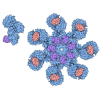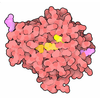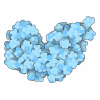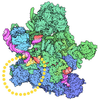+ データを開く
データを開く
- 基本情報
基本情報
| 登録情報 | データベース: PDB / ID: 6xkk | ||||||
|---|---|---|---|---|---|---|---|
| タイトル | Cryo-EM structure of the NLRP1-CARD filament | ||||||
 要素 要素 | NACHT, LRR and PYD domains-containing protein 1 | ||||||
 キーワード キーワード | IMMUNE SYSTEM / Filament / inflammasome / signaling / UPA / CARD / FIIND / NLRP1 | ||||||
| 機能・相同性 |  機能・相同性情報 機能・相同性情報NLRP1 inflammasome complex assembly / NLRP1 inflammasome complex / The NLRP1 inflammasome / NLRP3 inflammasome complex / self proteolysis / cysteine-type endopeptidase activator activity / 加水分解酵素; プロテアーゼ; ペプチド結合加水分解酵素 / pattern recognition receptor signaling pathway / cysteine-type endopeptidase activator activity involved in apoptotic process / cellular response to UV-B ...NLRP1 inflammasome complex assembly / NLRP1 inflammasome complex / The NLRP1 inflammasome / NLRP3 inflammasome complex / self proteolysis / cysteine-type endopeptidase activator activity / 加水分解酵素; プロテアーゼ; ペプチド結合加水分解酵素 / pattern recognition receptor signaling pathway / cysteine-type endopeptidase activator activity involved in apoptotic process / cellular response to UV-B / pattern recognition receptor activity / pyroptotic inflammatory response / response to muramyl dipeptide / signaling adaptor activity / antiviral innate immune response / activation of innate immune response / intrinsic apoptotic signaling pathway / positive regulation of interleukin-1 beta production / molecular condensate scaffold activity / protein homooligomerization / 加水分解酵素; 酸無水物に作用; 酸無水物に作用・細胞または細胞小器官の運動に関与 / positive regulation of inflammatory response / peptidase activity / double-stranded RNA binding / regulation of inflammatory response / double-stranded DNA binding / neuron apoptotic process / regulation of apoptotic process / defense response to virus / defense response to bacterium / inflammatory response / protein domain specific binding / apoptotic process / nucleolus / enzyme binding / signal transduction / ATP hydrolysis activity / nucleoplasm / ATP binding / nucleus / cytosol / cytoplasm 類似検索 - 分子機能 | ||||||
| 生物種 |  Homo sapiens (ヒト) Homo sapiens (ヒト) | ||||||
| 手法 | 電子顕微鏡法 / らせん対称体再構成法 / クライオ電子顕微鏡法 / 解像度: 3.72 Å | ||||||
 データ登録者 データ登録者 | Hollingsworth, L.R. / David, L. / Li, Y. / Sharif, H. / Fontana, P. / Fu, T. / Wu, H. | ||||||
| 資金援助 |  米国, 1件 米国, 1件
| ||||||
 引用 引用 |  ジャーナル: Nat Commun / 年: 2021 ジャーナル: Nat Commun / 年: 2021タイトル: Mechanism of filament formation in UPA-promoted CARD8 and NLRP1 inflammasomes. 著者: L Robert Hollingsworth / Liron David / Yang Li / Andrew R Griswold / Jianbin Ruan / Humayun Sharif / Pietro Fontana / Elizabeth L Orth-He / Tian-Min Fu / Daniel A Bachovchin / Hao Wu /  要旨: NLRP1 and CARD8 are related cytosolic sensors that upon activation form supramolecular signalling complexes known as canonical inflammasomes, resulting in caspase-1 activation, cytokine maturation ...NLRP1 and CARD8 are related cytosolic sensors that upon activation form supramolecular signalling complexes known as canonical inflammasomes, resulting in caspase-1 activation, cytokine maturation and/or pyroptotic cell death. NLRP1 and CARD8 use their C-terminal (CT) fragments containing a caspase recruitment domain (CARD) and the UPA (conserved in UNC5, PIDD, and ankyrins) subdomain for self-oligomerization, which in turn form the platform to recruit the inflammasome adaptor ASC (apoptosis-associated speck-like protein containing a CARD) or caspase-1, respectively. Here, we report cryo-EM structures of NLRP1-CT and CARD8-CT assemblies, in which the respective CARDs form central helical filaments that are promoted by oligomerized, but flexibly linked, UPAs surrounding the filaments. Through biochemical and cellular approaches, we demonstrate that the UPA itself reduces the threshold needed for NLRP1-CT and CARD8-CT filament formation and signalling. Structural analyses provide insights on the mode of ASC recruitment by NLRP1-CT and the contrasting direct recruitment of caspase-1 by CARD8-CT. We also discover that subunits in the central NLRP1 filament dimerize with additional exterior CARDs, which roughly doubles its thickness and is unique among all known CARD filaments. Finally, we engineer and determine the structure of an ASC-caspase-1 octamer, which suggests that ASC uses opposing surfaces for NLRP1, versus caspase-1, recruitment. Together these structures capture the architecture and specificity of the active NLRP1 and CARD8 inflammasomes in addition to key heteromeric CARD-CARD interactions governing inflammasome signalling. | ||||||
| 履歴 |
|
- 構造の表示
構造の表示
| ムービー |
 ムービービューア ムービービューア |
|---|---|
| 構造ビューア | 分子:  Molmil Molmil Jmol/JSmol Jmol/JSmol |
- ダウンロードとリンク
ダウンロードとリンク
- ダウンロード
ダウンロード
| PDBx/mmCIF形式 |  6xkk.cif.gz 6xkk.cif.gz | 676.7 KB | 表示 |  PDBx/mmCIF形式 PDBx/mmCIF形式 |
|---|---|---|---|---|
| PDB形式 |  pdb6xkk.ent.gz pdb6xkk.ent.gz | 527.4 KB | 表示 |  PDB形式 PDB形式 |
| PDBx/mmJSON形式 |  6xkk.json.gz 6xkk.json.gz | ツリー表示 |  PDBx/mmJSON形式 PDBx/mmJSON形式 | |
| その他 |  その他のダウンロード その他のダウンロード |
-検証レポート
| 文書・要旨 |  6xkk_validation.pdf.gz 6xkk_validation.pdf.gz | 1.3 MB | 表示 |  wwPDB検証レポート wwPDB検証レポート |
|---|---|---|---|---|
| 文書・詳細版 |  6xkk_full_validation.pdf.gz 6xkk_full_validation.pdf.gz | 1.3 MB | 表示 | |
| XML形式データ |  6xkk_validation.xml.gz 6xkk_validation.xml.gz | 78.8 KB | 表示 | |
| CIF形式データ |  6xkk_validation.cif.gz 6xkk_validation.cif.gz | 129.5 KB | 表示 | |
| アーカイブディレクトリ |  https://data.pdbj.org/pub/pdb/validation_reports/xk/6xkk https://data.pdbj.org/pub/pdb/validation_reports/xk/6xkk ftp://data.pdbj.org/pub/pdb/validation_reports/xk/6xkk ftp://data.pdbj.org/pub/pdb/validation_reports/xk/6xkk | HTTPS FTP |
-関連構造データ
| 関連構造データ |  22220MC 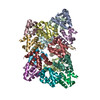 6xkjC  7keuC M: このデータのモデリングに利用したマップデータ C: 同じ文献を引用 ( |
|---|---|
| 類似構造データ | |
| 電子顕微鏡画像生データ |  EMPIAR-10564 (タイトル: NLRP1-CT filament / Data size: 534.7 EMPIAR-10564 (タイトル: NLRP1-CT filament / Data size: 534.7 Data #1: Unaligned multi-frame micrographs [micrographs - multiframe]) |
- リンク
リンク
- 集合体
集合体
| 登録構造単位 | 
| |||||||||||||||||||||||||||||||||||||||||||||||||||||||||||||||||||||||||||||||||||||||||||||||||||||||||||||||||||||||||||||||||||||||||||||||||||||||||||||||||||||||||||||||||||||||||||||
|---|---|---|---|---|---|---|---|---|---|---|---|---|---|---|---|---|---|---|---|---|---|---|---|---|---|---|---|---|---|---|---|---|---|---|---|---|---|---|---|---|---|---|---|---|---|---|---|---|---|---|---|---|---|---|---|---|---|---|---|---|---|---|---|---|---|---|---|---|---|---|---|---|---|---|---|---|---|---|---|---|---|---|---|---|---|---|---|---|---|---|---|---|---|---|---|---|---|---|---|---|---|---|---|---|---|---|---|---|---|---|---|---|---|---|---|---|---|---|---|---|---|---|---|---|---|---|---|---|---|---|---|---|---|---|---|---|---|---|---|---|---|---|---|---|---|---|---|---|---|---|---|---|---|---|---|---|---|---|---|---|---|---|---|---|---|---|---|---|---|---|---|---|---|---|---|---|---|---|---|---|---|---|---|---|---|---|---|---|---|---|
| 1 |
| |||||||||||||||||||||||||||||||||||||||||||||||||||||||||||||||||||||||||||||||||||||||||||||||||||||||||||||||||||||||||||||||||||||||||||||||||||||||||||||||||||||||||||||||||||||||||||||
| 対称性 | らせん対称: (回転対称性: 1 / Dyad axis: no / N subunits divisor: 1 / Num. of operations: 44 / Rise per n subunits: 5.1 Å / Rotation per n subunits: -100.8 °) | |||||||||||||||||||||||||||||||||||||||||||||||||||||||||||||||||||||||||||||||||||||||||||||||||||||||||||||||||||||||||||||||||||||||||||||||||||||||||||||||||||||||||||||||||||||||||||||
| 非結晶学的対称性 (NCS) | NCSドメイン:
|
 ムービー
ムービー コントローラー
コントローラー



 UCSF Chimera
UCSF Chimera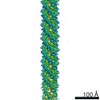



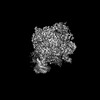


 PDBj
PDBj